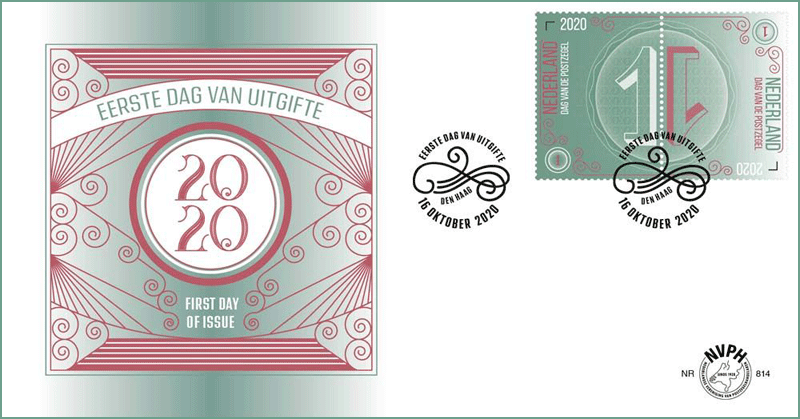[press release]
Royal Mail Reveals Special Stamps for Christmas 2020
- Royal Mail celebrates Christmas 2020 with a series of six stained-glass Nativity scenes
- The stamps showcase the extraordinary detail and craftmanship of this highly specialised decorative art, covering a range of eras, styles and technique
- Stained glass windows from the following churches are included in the set:
- St Andrew’s Church, East Lexham, Norfolk
- St Andrew’s Church, Coln Rogers, Gloucestershire
- Church of St James, Hollowell, Northamptonshire
- All Saints’ Parish Church, Otley, West Yorkshire
- St Columba’s Church, Topcliffe, North Yorkshire
- Christ Church, Coalville, Leicestershire
- The Nativity is a common subject in stained glass artistry and from the 13th Century onwards, scenes often focused on the relationship between the new-born infant Jesus and his mother, the Virgin Mary
- The techniques of making stained glass have hardly changed since the Middle Ages
- Help Royal Mail’s postmen and women deliver this year’s festive mail by posting early this Christmas and using the postcode
- The stamps are on sale from today (3 November). They will be available at www.royalmail.com/christmas2020, by phone on 03457 641 641 and 7,000 Post Offices across the UK. In addition, around 1,000 retailers will stock Christmas stamp booklets this year
Royal Mail has revealed its Christmas 2020 stamps featuring a series of six stained-glass Nativity scenes.
The stained-glass Nativity scenes showcase the extraordinary detail and craftmanship of this highly specialised decorative art, covering a range of eras, styles and technique.
Stained glass windows from the following churches are included in the set:
- St Andrew’s Church, East Lexham, Norfolk
- St Andrew’s Church, Coln Rogers, Gloucestershire
- Church of St James, Hollowell, Northamptonshire
- All Saints’ Parish Church, Otley, West Yorkshire
- St Columba’s Church, Topcliffe, North Yorkshire
- Christ Church, Coalville, Leicestershire
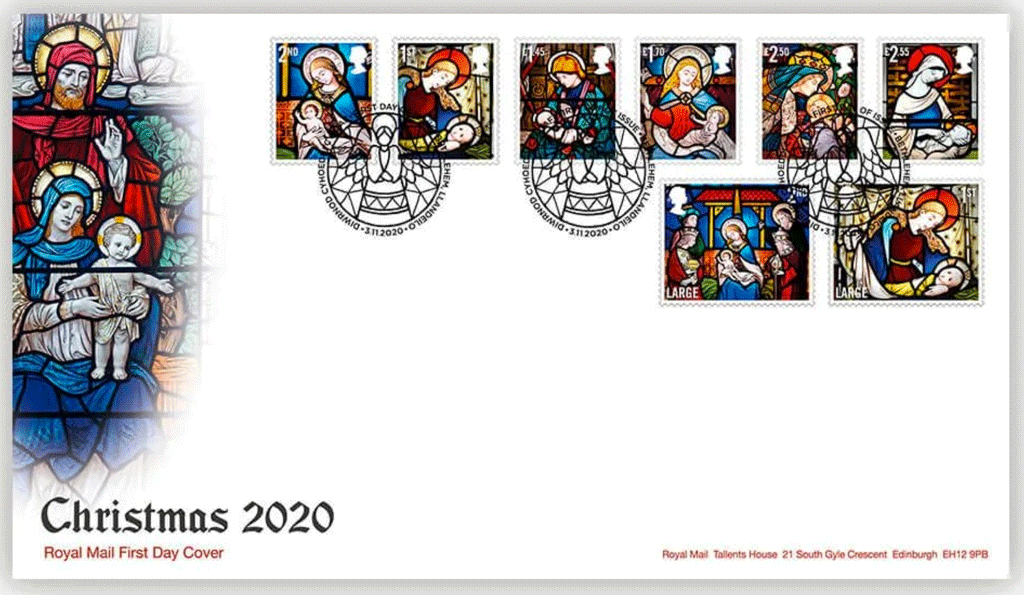
Traditionally, stained glass windows are assembled from pieces of coloured glass, held together with lead. The techniques of making stained glass have hardly changed since the Middle Ages.
The Nativity is a common subject in stained glass artistry and from the 13th century onwards, scenes often focused on the relationship between the new-born infant Jesus and his mother, the Virgin Mary.
Philip Parker, Royal Mail said: “Our beautiful Christmas stamps feature the Nativity as told through the artistry of different styles of stained-glass windows.”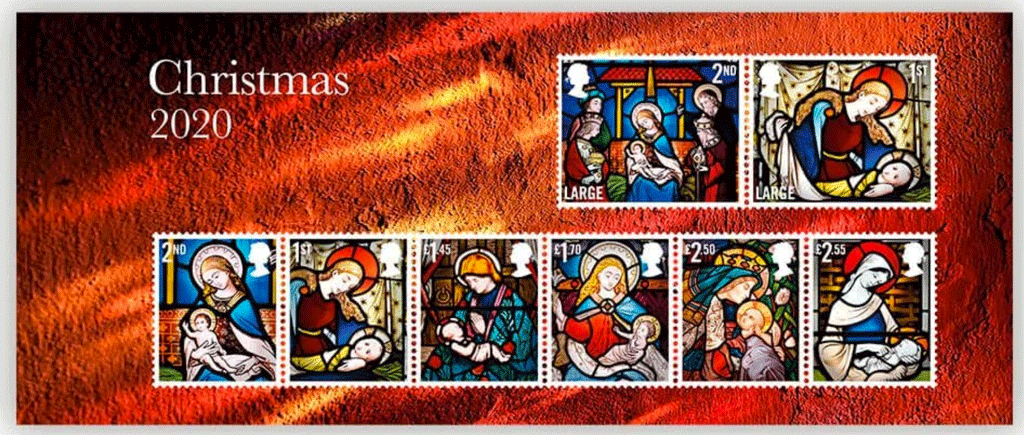
The origins of stained glass:
Stained glass originated in late antiquity. The Romans were the first to use coloured glass in windows, often set into plaster, stucco or metal frames. The oldest known examples of coloured window glass in England were excavated from the site of the former Anglo-Saxon monastery at Monkwearmouth Jarrow, Northumbria, which was founded in the 7th century.
By the 10th century, stained glass windows were being constructed with lead, which was more malleable and enabled greater versatility of design. Stained glass was a popular and expensive art form in the Middle Ages, used to decorate churches and other prestigious buildings. The translucent qualities of coloured glass meant that these windows projected coloured light into buildings, while illuminating colourful pictures.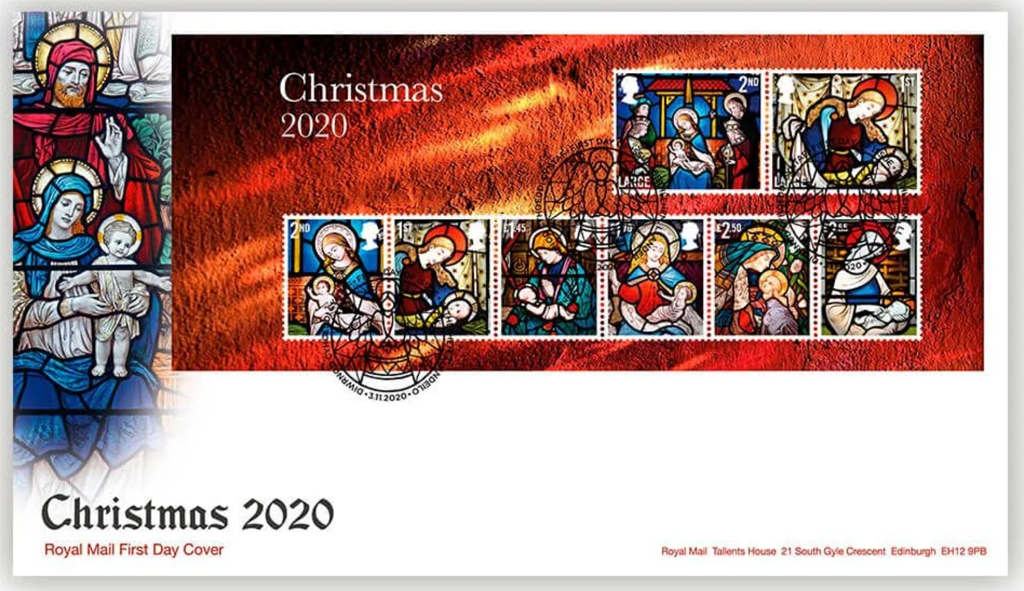
Panels of late 12th century stained glass survive at both Canterbury Cathedral and York Minster, but most surviving stained glass in the UK dates from the 13th century onwards. Following the Reformation in the 16th century, fewer religious stained glass windows were commissioned and, with a handful of exceptions, it was not until the 19th century that stained glass once again became a popular art form. Medieval windows provided inspiration for 19th century artists, who revived medieval techniques. Today, exquisite examples can be seen in the windows of our churches, town halls and other public and private buildings across the UK.
The stamps are on sale now and will be available at www.royalmail.com/christmas2020, by phone on 03457 641 641 and in 7,000 Post Offices across the UK. In addition, around 1,000 retailers will stock Christmas stamp books this year.
2nd Class stamp
Adoration of the Magi
Location: East window of St Andrew’s Church, East Lexham, Norfolk. This is an Anglican 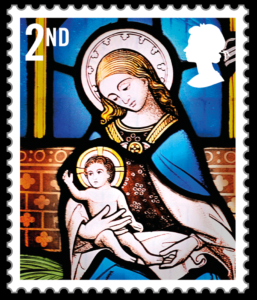 church, dedicated to Saint Andrew and is one of 124 existing round-tower churches in Norfolk. It is thought to date from circa 900AD and said to be one of the oldest in England.
church, dedicated to Saint Andrew and is one of 124 existing round-tower churches in Norfolk. It is thought to date from circa 900AD and said to be one of the oldest in England.
The Window: Mid-19th century stained glass, believed to have been made by Clayton & Bell in c.1859 – the designs adopted the gothic style of the 15th century in keeping with the perpendicular east window. The east window depicts scenes relating to Christ’s birth and death. The upper tier shows Christ carrying the Cross, The Crucifixion and Christ being taken down from the cross. The lower tier shows events related to Christ’s birth – the annunciation, Adoration of the Magi, and the presentation of Christ in the temple.
1st Class stamp
Virgin and Child
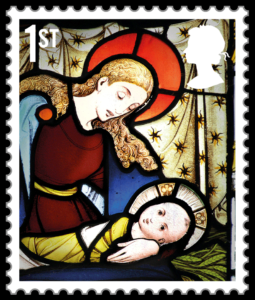 Location: St Andrew’s Church, Coln Rogers, Gloucestershire. This is an Anglican parish church and is dedicated to Saint Andrew. It is often described as being rather unique, as it has a Saxon nave and chancel which have survived almost intact. It dates to the mid-11th century.
Location: St Andrew’s Church, Coln Rogers, Gloucestershire. This is an Anglican parish church and is dedicated to Saint Andrew. It is often described as being rather unique, as it has a Saxon nave and chancel which have survived almost intact. It dates to the mid-11th century.
The Window: The three main lights of the east window of the church, dated c.1865 and made by the studio of Heaton, Butler and Bayne, focus on nativity scenes (including the Shepherds, Mary and Joseph with the Christ child and the three Magi). In the central light (from which this is a detail) Mary cradles the new-born Christ child.
£1.45 stamp
Virgin and Child
Location: Church of St James, Hollowell, Northamptonshire. The Church of St James was 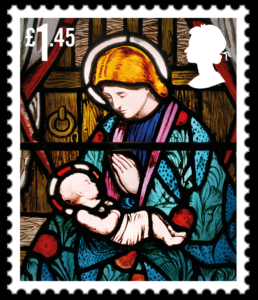 built in 1841 in the gothic style, and is known for its beautiful stained-glass windows in the eastern apse of the chancel, and the rose window above the west door.
built in 1841 in the gothic style, and is known for its beautiful stained-glass windows in the eastern apse of the chancel, and the rose window above the west door.
The Window: Chancel apse, south east window designed by Henry Holiday (1839-27) and made by J Powell & Sons, 1863. This is one of three lancet windows in the apse of the chancel. Each lancet window features a single narrative panel contained within a quatrefoil set against a background of decorative painted foliate grisaille (in the manner of the 13th century, decorated style). The north-eastern window depicts the Baptism of Christ, the central the Crucifixion, and the south-eastern (as pictured) shows the Virgin Mary and Christ child within the stable. The brightly coloured pieces of flashed ruby glass, and turquoise, blue, pink and purple tones demonstrates the wide variety and high-quality of the glass made at Powell’s glassworks.
£1.70 stamp
Virgin and Child
Location: All Saints Church, Otley, West Yorkshire. The first church building on the site was 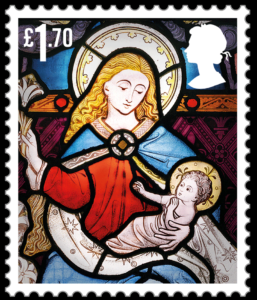 Anglo Saxon but only the foundations from this early church remain. A Norman church was built over them in the 11th century and this forms the present-day chancel. It was enlarged in about 1240. Further additions and modifications took place during later centuries, Including the installation of a number of stained-glass windows by various makers in the Victorian period.
Anglo Saxon but only the foundations from this early church remain. A Norman church was built over them in the 11th century and this forms the present-day chancel. It was enlarged in about 1240. Further additions and modifications took place during later centuries, Including the installation of a number of stained-glass windows by various makers in the Victorian period.
Window: This window is from a two-tier three light window in the South Transept of the church. The lower tier main lights show the Nativity with the Crucifixion in the upper tier above. It was manufactured by Clayton & Bell and installed in 1862. This image is the central scene of the Nativity. In the centre Mary is seated and holds the infant Jesus on her knee.
£2.50 stamp
Detail of the Holy Family
Location: St Columba’s Church, Topcliffe, North Yorkshire. St Columba’s is the parish 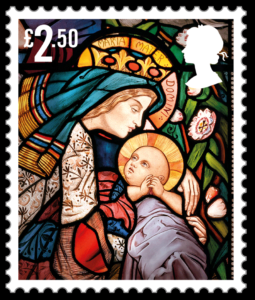 church of Topcliffe, near Thirskand the present building dates from the 13th century and was largely rebuilt by railway architect George T Andrews in 1885.
church of Topcliffe, near Thirskand the present building dates from the 13th century and was largely rebuilt by railway architect George T Andrews in 1885.
The Window: This well-known window is one of two windows located on the south side of the chancel of the church. The window is divided into three lights, showing three scenes in the life of Mary which also relate to the birth of Christ. On the left is the Annunciation, in the centre panel are Mary and her cousin and the panel on the right shows the Holy Family – Joseph, Mary and Jesus. This detail is from the scene of the Holy Family. It was designed by Michael Halliday and manufactured by Lavers & Barraud c.1860.
£2.55 stamp
Virgin and Child
Location: Christ Church, Coalville, Leicestershire. The church was built between 1836 and 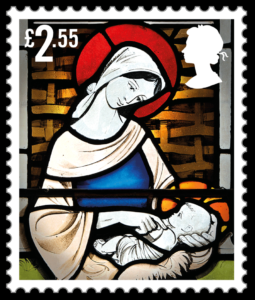 1838, with a west tower, large nave, transepts, chancel and vestry added later in 1936.
1838, with a west tower, large nave, transepts, chancel and vestry added later in 1936.
The Window: Whilst most of the glass is Victorian there are also three modern windows, which include the North chancel lancet window of the Nativity. The scene focuses on the virgin and child, with the ox and donkey watching over them (c. 1976). Harry Harvey (1922-2011) worked during the latter part of the twentieth-century producing stained-glass in a distinctive modern style. He died in 2011.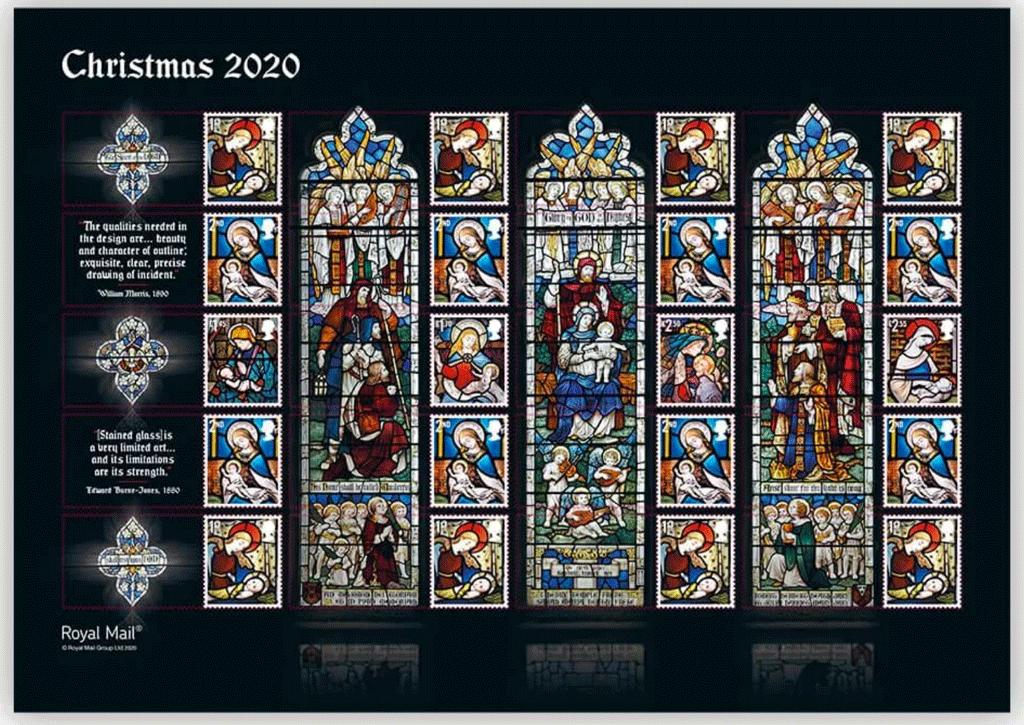
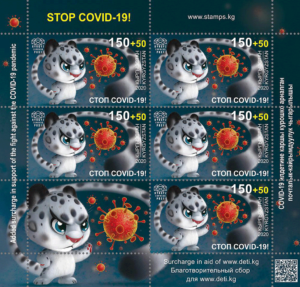 deed!
deed!

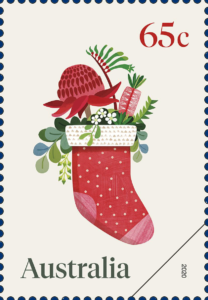 al and secular themes.
al and secular themes.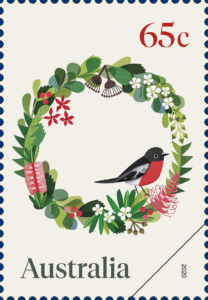 65c Wreath (secular)
65c Wreath (secular)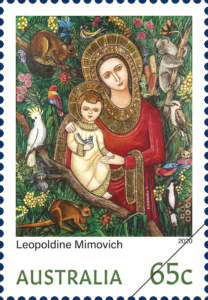 Paper: gummed: Tullis Russell
Paper: gummed: Tullis Russell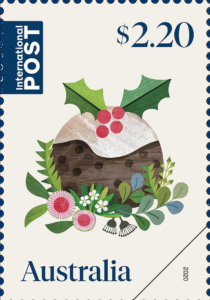
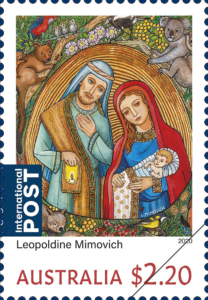
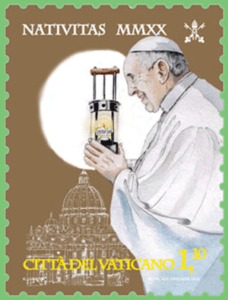 The Light of Peace from Bethlehem is the inspiring theme of the Vatican issue dedicated to Christmas 2020, including, in addition to the traditional stamps and booklet, also a leaflet in joint issue with Austria. In the Church of the Nativity in Bethlehem there is an oil lamp that has been burning perpetually for many centuries, fueled by oil donated in turn by all the Christian nations of the earth. Every year in December, just before Christmas, a child selected from among the Austrian scout groups for his particular commitment in the social field, draws from that flame is the light that will be spread throughout the planet as a symbol of peace and brotherhood among peoples, placing it near the nativity scenes of families and churches. This tradition began in 1986 as part of the
The Light of Peace from Bethlehem is the inspiring theme of the Vatican issue dedicated to Christmas 2020, including, in addition to the traditional stamps and booklet, also a leaflet in joint issue with Austria. In the Church of the Nativity in Bethlehem there is an oil lamp that has been burning perpetually for many centuries, fueled by oil donated in turn by all the Christian nations of the earth. Every year in December, just before Christmas, a child selected from among the Austrian scout groups for his particular commitment in the social field, draws from that flame is the light that will be spread throughout the planet as a symbol of peace and brotherhood among peoples, placing it near the nativity scenes of families and churches. This tradition began in 1986 as part of the 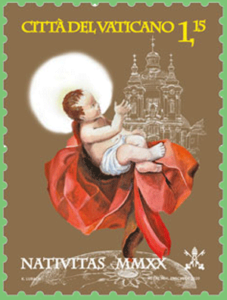 Christmas charity initiative “Licht ins Dunkel” – Light in the darkness – organized by the Austrian radio and television broadcaster ORF in Linz and aimed to the collection of spontaneous offers in support of disabled children, socially marginalized, but also of needy foreigners.
Christmas charity initiative “Licht ins Dunkel” – Light in the darkness – organized by the Austrian radio and television broadcaster ORF in Linz and aimed to the collection of spontaneous offers in support of disabled children, socially marginalized, but also of needy foreigners. Stamp format: 30 x 40 mm
Stamp format: 30 x 40 mm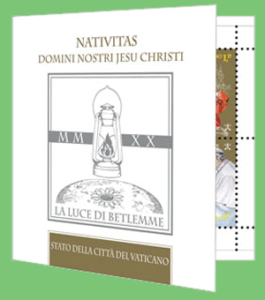
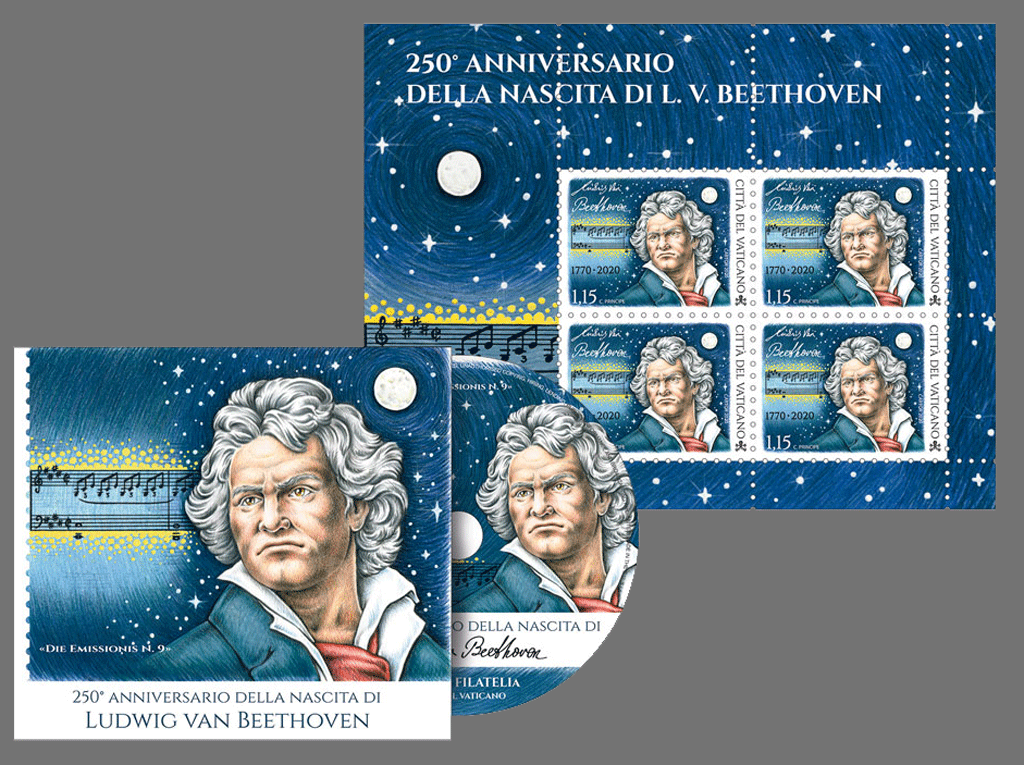
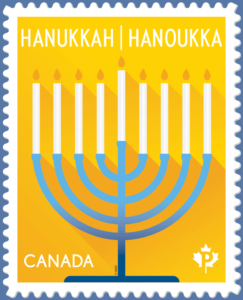 TORONTO – On November 5, Canada Post issued a new commemorative stamp to mark Hanukkah – the Jewish Festival of Lights. The eight-day celebration begins at nightfall on the 25th day of Kislev in the Hebrew calendar, this year December 10. The stamp is available in advance, so Canadians can use it to send holiday greetings.
TORONTO – On November 5, Canada Post issued a new commemorative stamp to mark Hanukkah – the Jewish Festival of Lights. The eight-day celebration begins at nightfall on the 25th day of Kislev in the Hebrew calendar, this year December 10. The stamp is available in advance, so Canadians can use it to send holiday greetings.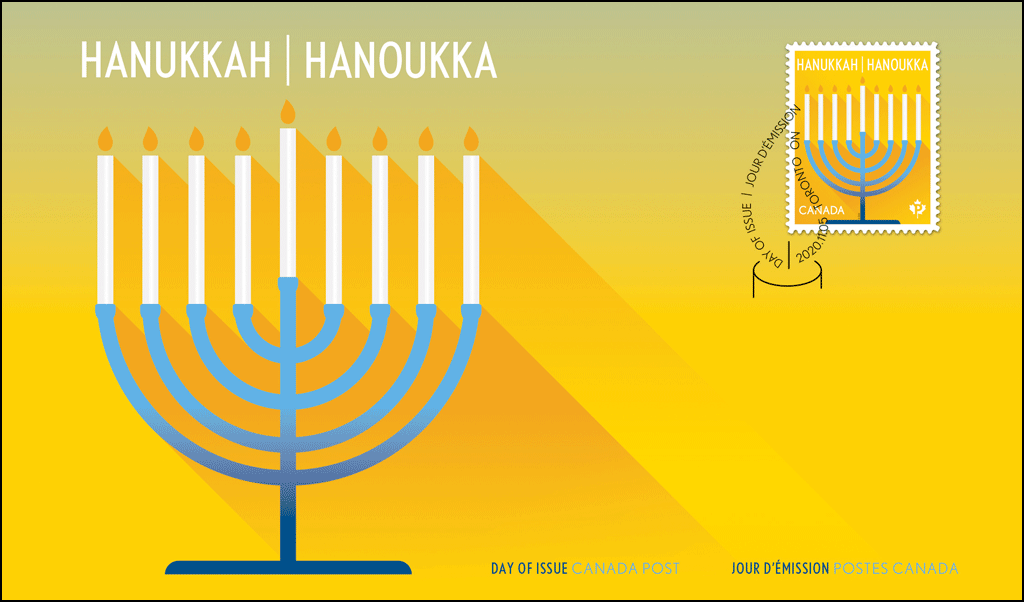

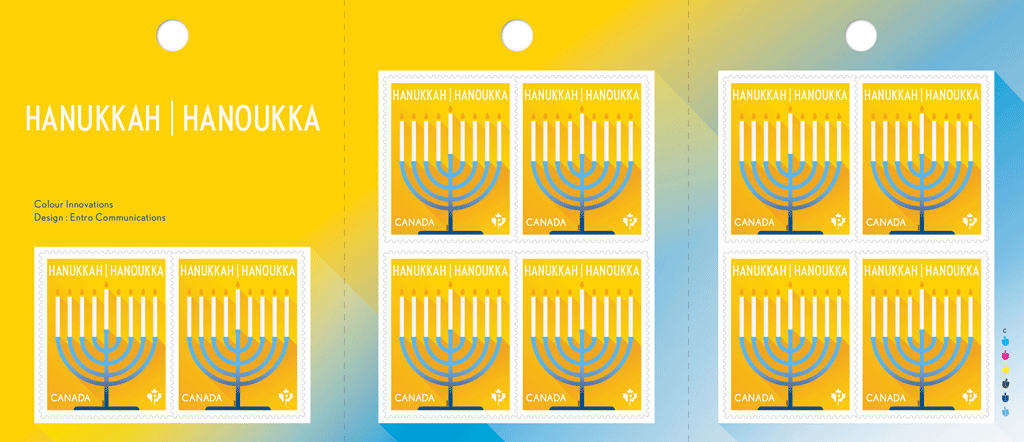
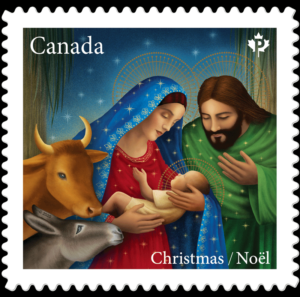 issues to help Canadians make their cards and letters more festive. Once again this year, Canadians can make their mail merrier with their choice of stamps bearing either sacred or secular holiday imagery.
issues to help Canadians make their cards and letters more festive. Once again this year, Canadians can make their mail merrier with their choice of stamps bearing either sacred or secular holiday imagery.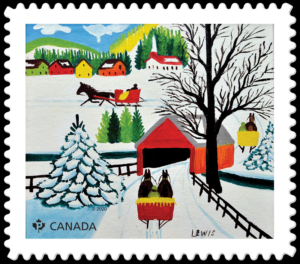 scenes by Canadian folk artist Maud Lewis. Lewis’ earliest works were Christmas cards painted under the guidance of her mother and sold door to door to her neighbours in rural Nova Scotia. This issue features seasonal works from the collection of the Art Gallery of Nova Scotia in Halifax: Winter Sleigh Ride (12-stamp booklet at the Permanent™ domestic rate), Team of Oxen in Winter (six-stamp booklet at the U.S. rate) and Family and Sled (six-stamp booklet at the international rate). A souvenir sheet, depicting Lewis’ whimsical cats, and a souvenir sheet Official First Day Cover, cancelled in Digby, Nova Scotia, round out the issue.
scenes by Canadian folk artist Maud Lewis. Lewis’ earliest works were Christmas cards painted under the guidance of her mother and sold door to door to her neighbours in rural Nova Scotia. This issue features seasonal works from the collection of the Art Gallery of Nova Scotia in Halifax: Winter Sleigh Ride (12-stamp booklet at the Permanent™ domestic rate), Team of Oxen in Winter (six-stamp booklet at the U.S. rate) and Family and Sled (six-stamp booklet at the international rate). A souvenir sheet, depicting Lewis’ whimsical cats, and a souvenir sheet Official First Day Cover, cancelled in Digby, Nova Scotia, round out the issue.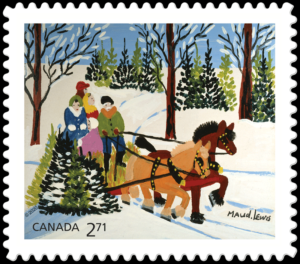 nouveaux jeux de timbres qui égayeront les cartes et les lettres des Canadiens. Cette année encore, ces derniers pourront mettre un peu de joie sur leur courrier des Fêtes avec des timbres consacrés à un thème religieux ou profane.
nouveaux jeux de timbres qui égayeront les cartes et les lettres des Canadiens. Cette année encore, ces derniers pourront mettre un peu de joie sur leur courrier des Fêtes avec des timbres consacrés à un thème religieux ou profane.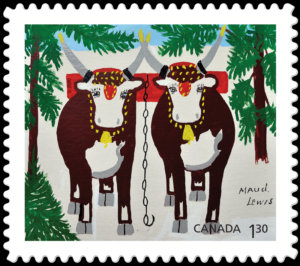 L’Heureux, sont ornés de trois scènes joyeuses de l’artiste folklorique canadienne Maud Lewis. Les premières œuvres de l’artiste sont des cartes de Noël qu’elle peint en suivant les conseils de sa mère et qu’elle vend à des voisins en faisant du porte-à-porte en Nouvelle-Écosse. Cette émission est composée de trois œuvres qui font partie de la collection du Musée des beaux-arts de la Nouvelle-Écosse à Halifax : Winter Sleigh Ride (carnet de 12 timbres PermanentsMC au tarif du régime intérieur), Team of Oxen in Winter (carnet de 6 timbres au tarif des envois à destination des États-Unis) et Family and Sled (carnet de 6 timbres au tarif du régime international). Le bloc-feuillet, présentant une illustration fantaisiste de chats créée par Maud Lewis, et le pli Premier Jour officiel du bloc-feuillet, oblitéré à Digby, en Nouvelle-Écosse, complètent l’émission.
L’Heureux, sont ornés de trois scènes joyeuses de l’artiste folklorique canadienne Maud Lewis. Les premières œuvres de l’artiste sont des cartes de Noël qu’elle peint en suivant les conseils de sa mère et qu’elle vend à des voisins en faisant du porte-à-porte en Nouvelle-Écosse. Cette émission est composée de trois œuvres qui font partie de la collection du Musée des beaux-arts de la Nouvelle-Écosse à Halifax : Winter Sleigh Ride (carnet de 12 timbres PermanentsMC au tarif du régime intérieur), Team of Oxen in Winter (carnet de 6 timbres au tarif des envois à destination des États-Unis) et Family and Sled (carnet de 6 timbres au tarif du régime international). Le bloc-feuillet, présentant une illustration fantaisiste de chats créée par Maud Lewis, et le pli Premier Jour officiel du bloc-feuillet, oblitéré à Digby, en Nouvelle-Écosse, complètent l’émission. 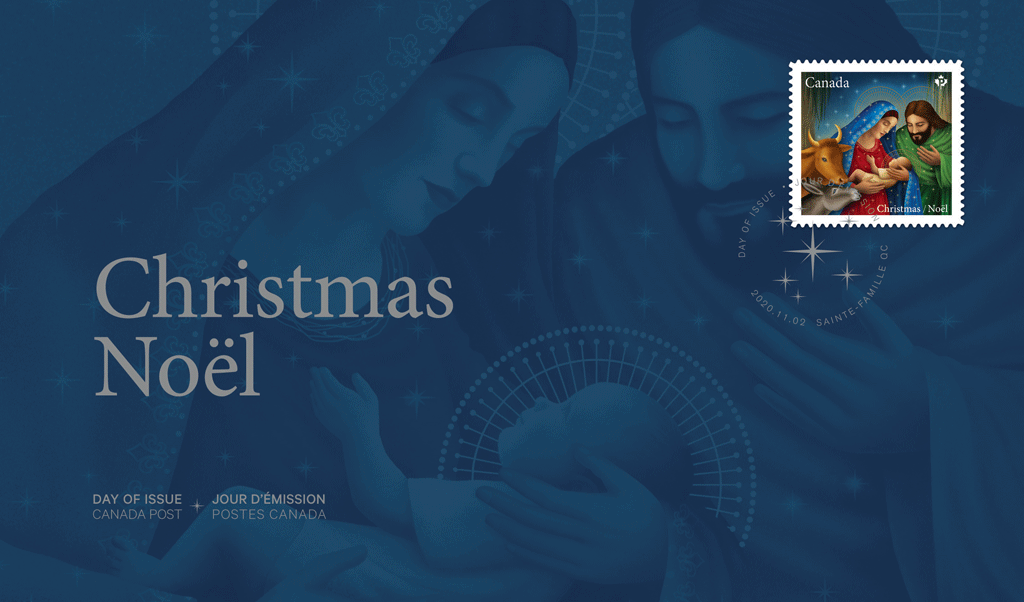
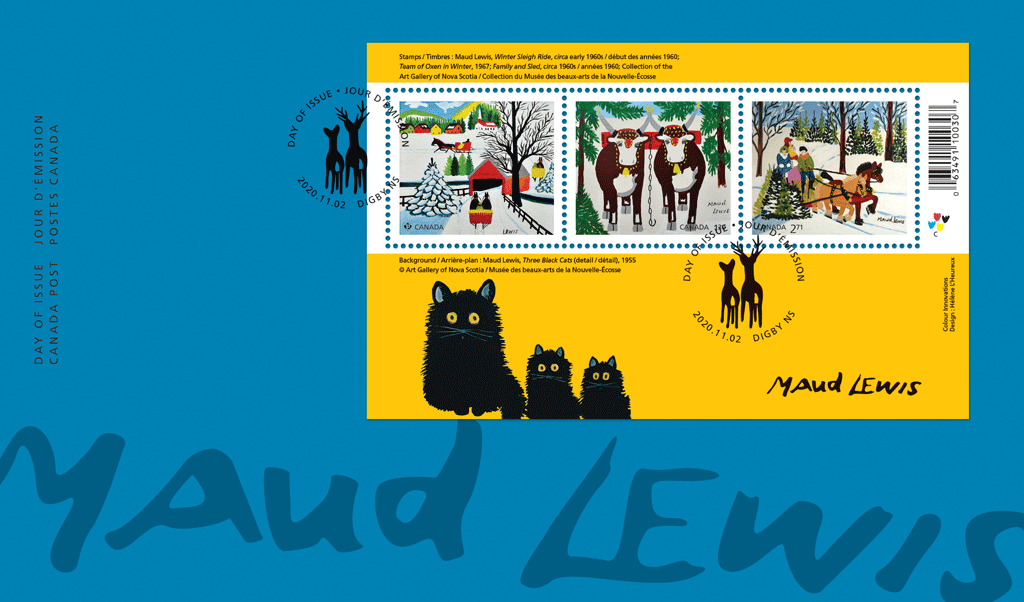






 church, dedicated to Saint Andrew and is one of 124 existing round-tower churches in Norfolk. It is thought to date from circa 900AD and said to be one of the oldest in England.
church, dedicated to Saint Andrew and is one of 124 existing round-tower churches in Norfolk. It is thought to date from circa 900AD and said to be one of the oldest in England. Location: St Andrew’s Church, Coln Rogers, Gloucestershire. This is an Anglican parish church and is dedicated to Saint Andrew. It is often described as being rather unique, as it has a Saxon nave and chancel which have survived almost intact. It dates to the mid-11th century.
Location: St Andrew’s Church, Coln Rogers, Gloucestershire. This is an Anglican parish church and is dedicated to Saint Andrew. It is often described as being rather unique, as it has a Saxon nave and chancel which have survived almost intact. It dates to the mid-11th century. built in 1841 in the gothic style, and is known for its beautiful stained-glass windows in the eastern apse of the chancel, and the rose window above the west door.
built in 1841 in the gothic style, and is known for its beautiful stained-glass windows in the eastern apse of the chancel, and the rose window above the west door. Anglo Saxon but only the foundations from this early church remain. A Norman church was built over them in the 11th century and this forms the present-day chancel. It was enlarged in about 1240. Further additions and modifications took place during later centuries, Including the installation of a number of stained-glass windows by various makers in the Victorian period.
Anglo Saxon but only the foundations from this early church remain. A Norman church was built over them in the 11th century and this forms the present-day chancel. It was enlarged in about 1240. Further additions and modifications took place during later centuries, Including the installation of a number of stained-glass windows by various makers in the Victorian period. church of Topcliffe, near Thirskand the present building dates from the 13th century and was largely rebuilt by railway architect George T Andrews in 1885.
church of Topcliffe, near Thirskand the present building dates from the 13th century and was largely rebuilt by railway architect George T Andrews in 1885. 1838, with a west tower, large nave, transepts, chancel and vestry added later in 1936.
1838, with a west tower, large nave, transepts, chancel and vestry added later in 1936.
 OTTAWA – The Canada Post Community Foundation today announced that approximately $1.3 million was raised for grants to groups that help children in communities across Canada.
OTTAWA – The Canada Post Community Foundation today announced that approximately $1.3 million was raised for grants to groups that help children in communities across Canada.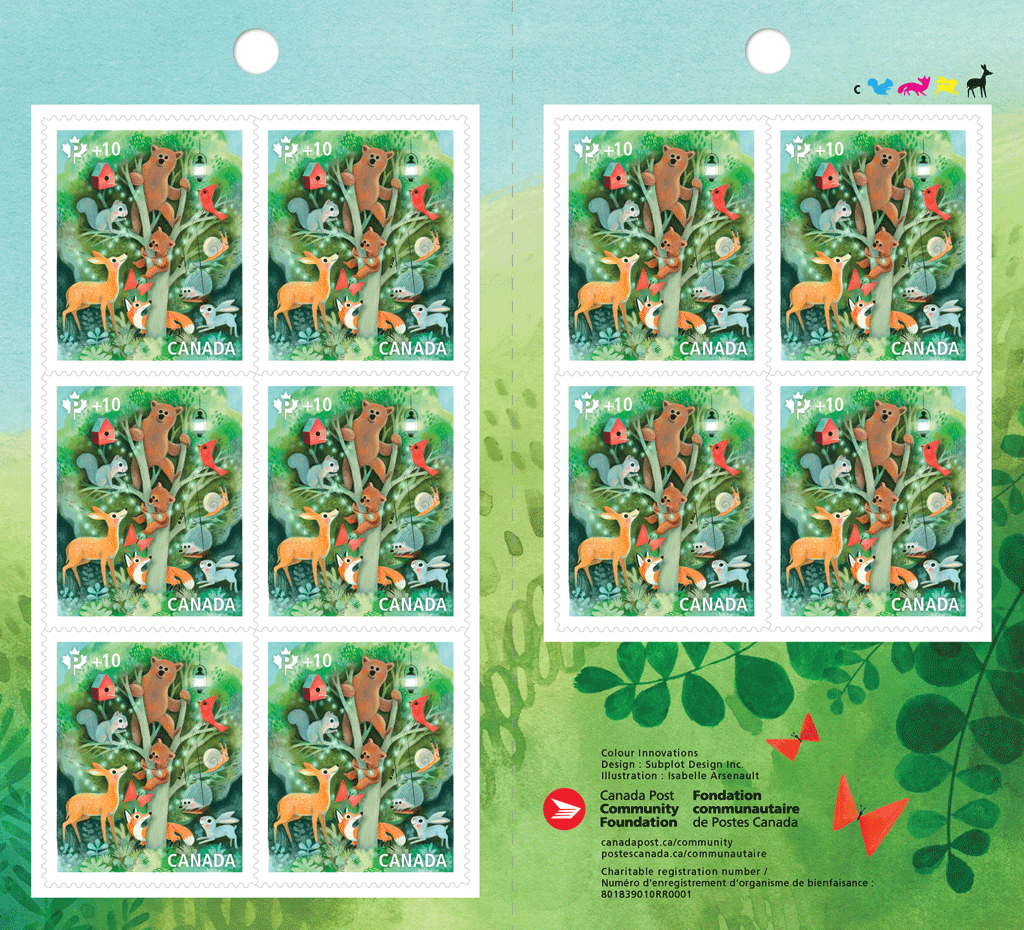
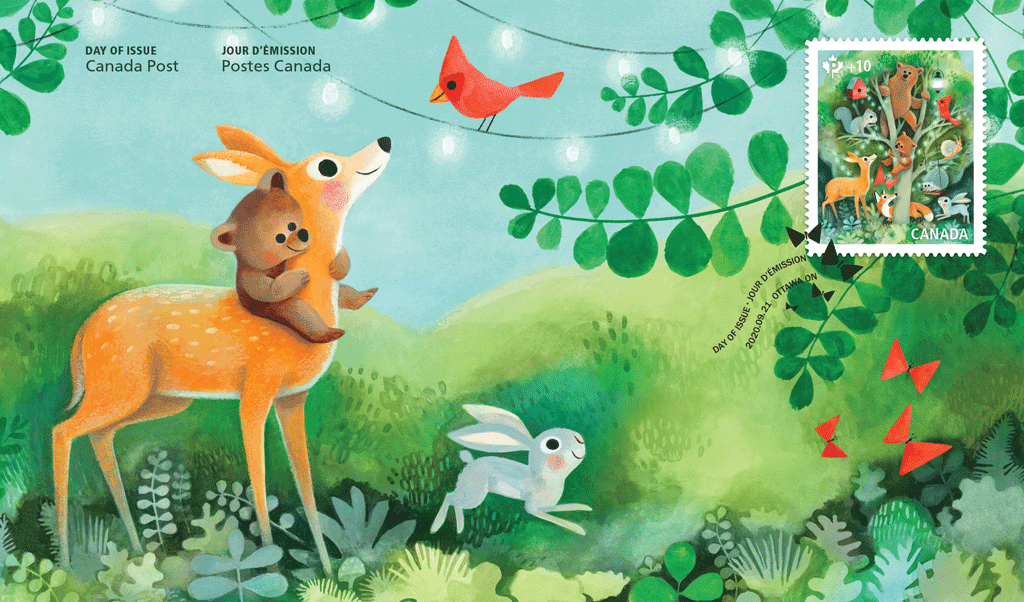
 [en Français]
[en Français]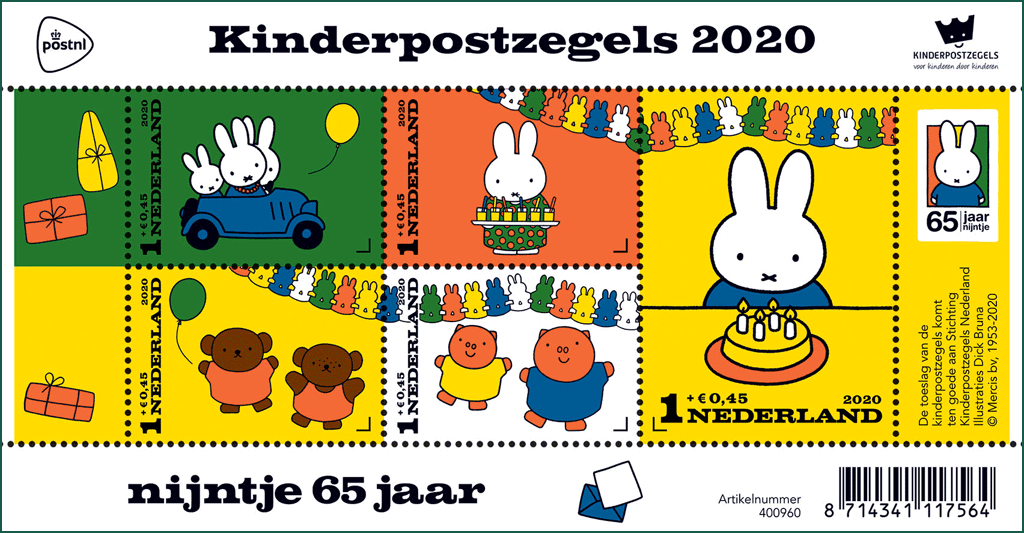
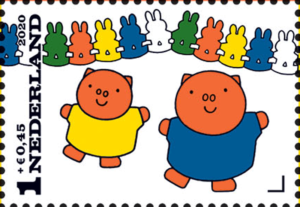 both physically and digitally. With a special sales box and order forms through the letterbox, it is also possible to keep the necessary distance at the door. For example, children can send personal video messages to offer children’s stamps (for more information about this, click here).
both physically and digitally. With a special sales box and order forms through the letterbox, it is also possible to keep the necessary distance at the door. For example, children can send personal video messages to offer children’s stamps (for more information about this, click here).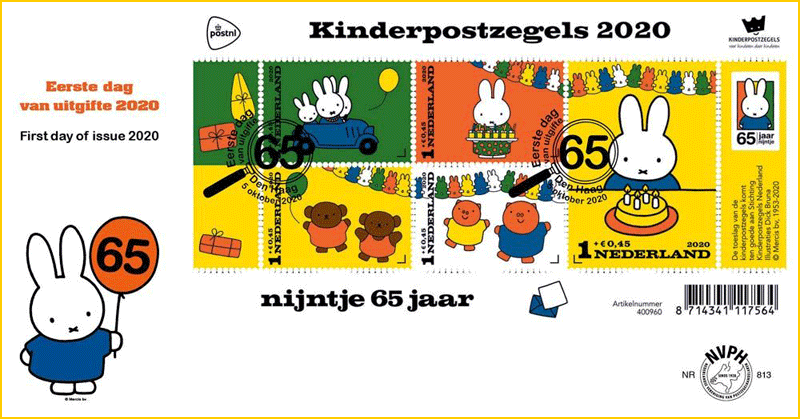
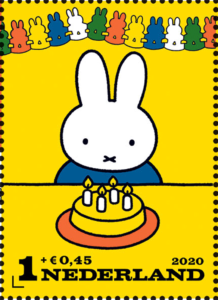 which has now become intangible cultural heritage. ”
which has now become intangible cultural heritage. ”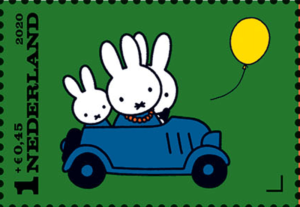 groups 7 and 8. The children’s stamps are also available from 5 October, while supplies last, from Bruna, via our website and on the website of the Children’s Postage Stamps Foundation Netherlands.
groups 7 and 8. The children’s stamps are also available from 5 October, while supplies last, from Bruna, via our website and on the website of the Children’s Postage Stamps Foundation Netherlands.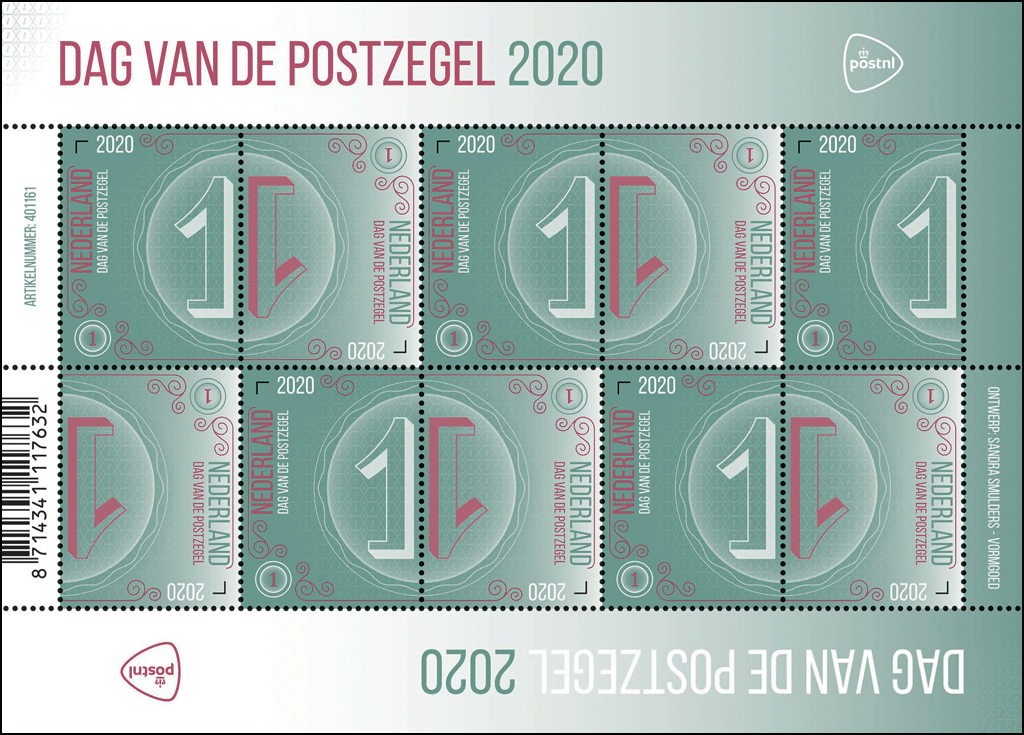
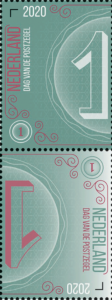 given low postage values to encourage the sending of newspapers and other printed matter by post. Based on a design with a large value figure, Joh. Enschedé & Zonen from Haarlem 144 years ago a uniform series with denominations of ½, 1, 1½, 2 and 2½ cents.
given low postage values to encourage the sending of newspapers and other printed matter by post. Based on a design with a large value figure, Joh. Enschedé & Zonen from Haarlem 144 years ago a uniform series with denominations of ½, 1, 1½, 2 and 2½ cents.